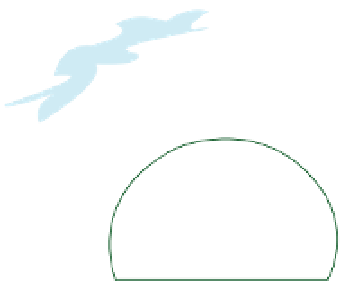Biomedical Engineering Reference
In-Depth Information
Sunlight
Infrared
rays
radiated
into space
Reflected
Sunlight
Clouds
Heat reflected
back to planet
Atmosphere
FIGURE 14.48
Depiction of the greenhouse effect resulting in thermal radiation being reflected back toward
the earth's surface.
surrounding air and buildings, resulting in the warm temperatures that allow us to live on
this planet. This phenomenon is known as the
(Figure 14.48).
You have probably experienced the greenhouse effect firsthand if you ever left your car
unattended on a sunny day. The thermal radiation is transmitted through the windshield
and hits the seats and dashboard. The frequency shift occurs, and the reflected energy
is then reflected back to the windshield, only now at a high reflectivity and low transmis-
sivity. As such, the inside of the car heats up, often up to 20-30 degrees higher than the
ambient air. A sunscreen on the window will reduce the amount of radiation entering the
car and keep it cooler.
Commercial greenhouses purposefully trap the heat via the greenhouse effect and use
some limited screening to control the amount of trapped heat. The increased heat allows
the plants to remain at a relatively warm temperature and avoid the changes in temperature
with changing air currents and air temperature. By keeping the doors to the greenhouse
closed, the temperature can be somewhat maintained overnight. A commercial greenhouse is
shown in Figure 14.49.
Heat loss at night via radiation occurs as reemitted energy from the earth's surface to the
dark night sky. The amount of radiation energy released at night depends on whether the
sky is clear or cloudy.
greenhouse effect
14.3.7 Heat Loss via Respiration
When air is inspired into the lungs, heat and water vapor are transferred to the air by
convection and evaporation from the surface lining the respiratory tract. By the time the
air has reached the deepest parts of the lungs, the air is at deep body temperature (37
C)
and saturated with water vapor (47 mm Hg partial pressure). As the air moves outward
through the respiratory tract during expiration, some heat is transferred back to the body
















